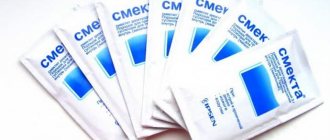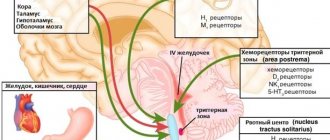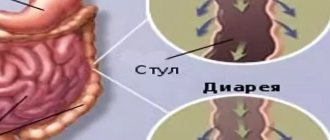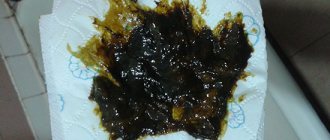Causes of vomiting in a child
If your baby is vomiting, the reasons may be:
- diseases of the gastrointestinal tract (GIT);
- acute appendicitis;
- poor nutrition;
- infections;
- intoxication;
- metabolic disorders;
- heart or kidney failure;
- neurological disorders;
- meningitis;
- epilepsy;
- head injuries;
- stress, nervous tension.
In children under one year of age, the most common causes of vomiting are overeating combined with immaturity of the digestive system. However, vomiting should not be confused with regurgitation, which, in most cases, is the norm for infants.
How often can a gastroscopy procedure be performed?
Gastroscopy is one of the most informative methods for studying the condition of the gastrointestinal tract (its upper section), since this procedure allows you to visually assess the presence of damage to the gastric mucosa, the presence of polyps, erosions, ulcers, bleeding and other pathologies of the walls of the stomach and duodenum. Many patients are interested in the question of how safe this generally unpleasant procedure is, and how often gastroscopy can be done in the presence of various pathologies of the digestive tract.
The frequency of gastroscopy is determined by the attending physician.
However, this study is also prescribed for many other diseases. For example, cardiovascular: before performing a coronography, an endovascular cardiologist must ensure that there are no gastric erosions or ulcers. Otherwise, the operation will be postponed, since the patient on the eve of surgery must take strong antithrombotic drugs that thin the blood and promote bleeding.
- 1 Indications for gastroscopy
- 2 How is gastroscopy performed?
- 3 Duration of the procedure
- 4 Decoding the results
- 5 How often can gastroscopy be done
- 6 Conclusion
Indications for gastroscopy
General symptoms such as nausea, diarrhea, vomiting do not always indicate the presence of diseases of the digestive tract, but if the patient complains, he will most likely be prescribed a series of tests that should confirm or refute suspicions of gastritis, duodenitis or other gastric pathologies.
Other indications for prescribing gastroscopy include the following:
- suspicion of the presence of malignant neoplasms in the stomach/esophagus;
- the need for constant monitoring of the condition of the gastric epithelium in the treatment of gastrointestinal diseases;
- symptoms of gastric bleeding;
- if a foreign object enters the stomach;
- if the patient often experiences pain in the epigastric region;
- difficulties experienced by the patient when eating;
- to clarify the diagnosis for a number of diseases not related to gastrointestinal pathologies.
FGDS should be prescribed with caution to children under six years of age, if there is a history of severe mental disorders, if the patient is diagnosed with exacerbation of chronic gastritis or gastric ulcer, or if there is a respiratory tract infection. In any case, the appointment of this procedure can occur repeatedly, and not knowing in what cases and how often gastroscopy of the stomach can be done is very worrying for many patients.
As for contraindications to the appointment of esophagogastroduodenoscopy (the official medical name for gastroscopy), there are few of them:
- some heart diseases;
- narrow compared to the standard entrance to the stomach;
- obesity 2 – 3 degrees;
- hypertension;
- kyphosis/scoliosis;
- a history of stroke/heart attack;
- congenital/acquired blood diseases.
How is gastroscopy performed?
An instrument that allows you to examine the condition of the inner walls of the stomach (and, if necessary, the duodenum) is a type of endoscope. A gastroscope consists of a hollow elastic tube containing a fiber-optic cable with an optical and illuminating device at the end. Through the mouth and esophagus, the hose is inserted into the stomach cavity for a thorough examination. Through the cable, the image is transmitted to the eyepiece or monitor screen, and the doctor conducting the study has the opportunity to study the condition of the epithelium in different parts of the stomach by turning and moving the tube in the desired direction.
Is gastroscopy harmful from the point of view of the condition of the esophagus and stomach walls in contact with a solid foreign object? Before the procedure, the gastroscope is thoroughly disinfected, so the likelihood of external infection is extremely low (no more than when eating fruits, bread or vegetables). The possibility of damaging the walls of the esophagus, stomach or duodenum is also close to zero, since the device in its basic form does not have sharp protrusions.
But the procedure itself requires compliance with certain restrictions on the part of the patient. First of all, it should be done on an empty stomach: the presence of food mass makes it very difficult to examine the mucous membrane, so it is very important not to eat 10 - 12 hours before gastroscopy. Approximately 100–120 minutes before the procedure, you should drink about 200 grams of liquid (weak tea or boiled water), which will clear the stomach walls of food debris and mucus. It is highly recommended to refrain from smoking the day before, as this provokes the secretion of gastric juice.
Immediately before insertion of the probe, the pharynx and upper part of the esophagus are anesthetized with a spray, and excessive anxiety is relieved with a subcutaneous injection of a mild sedative - the patient’s calm during the manipulation is very important, since fear can lead to involuntary sudden movements, which will make it difficult to examine the walls of the stomach.
Important: the shelf life of gastroscopy before surgery is one month, after which you will have to do a second examination (in a month, significant changes can occur in the stomach cavity, which can affect the result of the operation or be a direct contraindication to its implementation).
The gastroscopy itself is carried out in the following sequence:
- the patient undresses to the waist; if he has glasses or removable dentures that do not adhere well, they must also be removed;
- manipulation is carried out only in a lying position with a straight back, usually on the right side;
- a special mouthpiece is inserted into the mouth, which must be held firmly in order to prevent reflexive clenching of the teeth;
- after instructions to take a few sips and completely relax the larynx, the endoscope is inserted and lowered until it reaches the entrance to the stomach (the most unpleasant moment is the transition from the oral cavity to the esophagus, during which a natural urge to vomit occurs);
- then the doctor begins to turn the gastroscope, which allows you to examine the condition of the gastric cavities from all sides (the viewing angle of the device, as a rule, does not exceed 150 degrees).
Duration of the procedure
When performing a gastroscopy for diagnostic purposes, an experienced doctor only needs 12 to 15 minutes to examine the entire inner surface of the stomach, however, in some cases, a biopsy (taking a sample of epithelial tissue for laboratory testing) or other therapeutic manipulations (for example, administering medications) may be necessary. Such a comprehensive study can last up to 25–40 minutes.
For some time after the manipulation, the patient should be in a supine position; eating during gastroscopy without a biopsy is allowed after 60 minutes. If the procedure was carried out with a biopsy taken, the first meal of non-hot food is allowed after 180 - 240 minutes. If the procedure is performed on a child under 6 years of age or a patient with a history of mental disorders, gastroscopy can be performed under general anesthesia.
Decoding the results
The uninitiated will probably not be able to interpret the resulting images, since the resulting picture will more likely resemble some kind of fantastic landscape. But an experienced doctor is able to make an accurate diagnosis, guided by the method of comparison with mucous membranes without pathologies.
Types and nature of vomiting in children
If vomiting occurs in a child, it is first necessary to determine its nature. Prolonged, repeated vomiting, as well as the presence of foreign impurities in the vomit, can signal various diseases.
- Vomiting with mucus. Such vomiting in an infant, in most cases, is not a sign of illness: the gag reflex can be triggered by overeating, and mucus enters the vomit from the bronchi and nasopharynx. In older children, vomiting with mucus often occurs due to diseases of the central nervous system (CNS), viral infections, poisoning, intestinal obstruction, foreign objects entering the esophagus, and also due to poor nutrition. In addition, the presence of a large amount of mucus in the secreted masses can be observed with brain lesions (meningitis, epilepsy, etc.).
- Vomiting with bile. The causes of this phenomenon may be cholecystitis, cholelithiasis, viral hepatitis, intestinal infections, as well as excessive consumption of junk food (fried, fatty, spicy foods, pickled foods). When vomiting with bile, the discharge usually has a yellow or yellowish-green color.
- Vomiting with blood. This type of vomiting is the most dangerous and requires immediate hospitalization. The presence of blood in the vomit indicates bleeding in the upper gastrointestinal tract. In this case, you should pay attention to the color of the blood. Bright red blood is usually seen in lesions of the pharynx, oral cavity, or esophagus. If the patches are dark brown, the sites of bleeding may be the lower parts of the stomach or duodenum. In this case, the color of the blood is affected by hydrochloric acid impurities.
Characteristics and description
In rare cases, bloody stools are caused by HIV infections. A complete examination will be required for an accurate diagnosis and adequate treatment. At first, the color of feces will help to understand the cause of such a strange, but still painless pathology.
Red stool, for example, may indicate malignancies and polyps. The latter are outgrowths of the intestinal mucosa. When they reach abnormal sizes, up to 70 ml of blood is released from the anus daily. If this symptom is left unattended, the benign cells of the polyp will soon become malignant.
Cherry color of feces indicates pathologies of the colon. The main symptoms of this disease are increasing stomach pain, flatulence and regular constipation. Together with feces, patients leave up to 50 ml of blood mixed with pus every day. Scarlet-colored stool is a sign of deepened anal fissures and hemorrhoids. Dark clots may indicate an intestinal diverticulum, and black stool may indicate pathology of the duodenum.
Vomiting in a child: how to help your baby before the doctor arrives?
If a child vomits, especially when attacks recur regularly, parents need to call a doctor. Drug treatment is prescribed by a pediatrician after examining the sick child and determining the nature of vomiting. In order to alleviate the baby’s condition before the doctor arrives, use the following recommendations:
- Lay the baby on his side. This will prevent vomit from entering the respiratory tract. Infants can be held in an upright position.
- To prevent dehydration, give your child a sip of water every 5 minutes. For the same purposes, you can use Regidron or other similar drugs.
- If your child is vomiting blood, place an ice pack or container of cold water on their stomach. This will help stop internal bleeding. In such cases, you cannot give the baby anything to drink and you need to call a doctor as soon as possible.
- After each attack of vomiting, the child needs to wipe his face and other areas of the skin that may have received vomit.
- Do not give your child food between bouts of vomiting.
Treatment in an inpatient department
If a person experiences black vomit, diagnostics and tests will tell you what it is and what disease it entails. After transporting the patient to the hospital, endoscopy of the digestive organs is performed. As a result of the study, the site of bleeding is determined. As an additional examination, the doctor may prescribe:
- undergoing an ultrasound examination of the abdominal organs;
- electrocardiogram;
- x-ray of the peritoneal organs;
- chest x-ray;
- donating blood for general analysis.
The examination result will indicate the disease, which will help to undertake effective treatment and avoid complications.
Based on where the bleeding occurs, therapy depends. The main goal of treatment is to stop bleeding. For this purpose, medications that stimulate blood clotting or surgery are used. A vasoconstrictor drug is prescribed in combination with hemostatic agents. For the surgical method of stopping bleeding, it is necessary to determine the source of bleeding. These methods include:
- ligation of damaged vessels;
- electrocoagulation;
- clipping;
- thermocoagulation;
- laparotomy intervention.
To replace blood loss, the patient is prescribed infusion therapy. Based on the severity of the lost blood, a solution is selected that can replenish the blood volume. If blood loss is minor, Ringer's saline or saline is used. For moderate cases, an infusion of Gelatinol, Reopoliglucin or Refortan is indicated. They can not only replenish blood loss, but also enhance oxygen transport. If the degree is severe, these drugs are used in combination with blood transfusion. The introduction is carried out by jet method. In extremely severe cases, the drug is infused into two veins. This reduces the risk of cardiac arrest.
What to do after vomiting stops?
Even if the child's vomiting has stopped, do not feed the baby for several hours and carefully monitor his condition.
Be sure to adjust your child's diet. Eliminate fatty, salty, spicy and smoked foods from your baby's diet. Give preference to liquid soups and broth. It is acceptable to give your child herbal tea, but in very moderate quantities. Do not feed your baby fresh vegetables and fruits for a while, as they can stimulate an irritated stomach lining. New foods should be added to the diet gradually and with great care.
To replenish the disturbed water-salt balance in the baby's body, Regidron is usually used. The child can also be given weak herbal infusions, teas (black and green), boiled water and rosehip decoction.
If your baby is vomiting, you should never self-medicate, especially if this condition does not go away and is accompanied by an increase in body temperature, pain in the abdomen and head, and also if the vomit contains blood.
How to stop vomiting in a child
Vomiting coffee grounds occurs when there is bleeding in the stomach or intestines. In this case, the vomit has a dark brownish or almost black tint and a specific granular structure. This condition can occur in people of any age and most often indicates dangerous pathological processes in the body. Vomiting coffee grounds requires immediate medical attention and is life-threatening.
Main reasons
There are many reasons why brown vomit may occur. These include the following diseases and some conditions:
- peptic ulcers of the gastrointestinal tract;
- oncological diseases of the stomach and esophagus;
- erosion of the stomach and growths of polyps on its walls;
- Mallory-Weiss disease;
- holes in the cardiac part of the stomach;
- varicose veins of the esophagus;
- deformation of the esophagus or stomach with sharp objects;
- cirrhosis of the liver, which occurs with impaired blood flow;
- poisoning from toxic plants, alcohol or chemicals.
Black vomit can also occur for other reasons, such as taking certain medications. Such medicines include:
- drugs of the narcotic group;
- infusions of medicinal herbs that provoke bleeding;
- non-steroidal anti-inflammatory drugs - aspirin, ibuprofen and indomethacin.
Dark brown vomiting most often indicates a disease of the gastrointestinal tract, but to accurately determine the root cause, you need to consider all possible factors.
If black vomiting is caused by taking certain medications, then no specific treatment is required. Usually, immediately after stopping the medication, black vomiting goes away without any consequences.
What other reasons could there be for vomiting black vomit?
During the process of vomiting, some of the contents in the digestive tract are released through the mouth or nose (rarely). Vomit of a dark red color (almost black) is a consequence of the formation of hydrochloric acid hematin due to the interaction of hydrochloric acid in the gastric juice with the blood.
Vomiting with black discharge may indicate the following pathologies:
- stomach or intestinal bleeding,
- neoplasms in the gastrointestinal tract,
- damage to the walls of the gastrointestinal tract of the ulcerative type,
- injuries to internal organs,
In addition to the above reasons, vomiting can be provoked by medications that are taken without measure simultaneously with drugs or potent herbs. Sometimes the black color of vomit depends on the amount of foods consumed the day before or the content of coloring substances in them (dark berries, chocolate, etc.).
Often, vomiting of black masses is accompanied by other signs, namely: weakness, indifference to everything that is happening, pale skin color, dizziness, a blue tint to the mucous membranes, and black-colored bowel movements. In case of intestinal obstruction, vomit changes color. At the first stages, they contain foods that have not been digested by the stomach. Over time, the vomit turns yellow-green in color due to the presence of bile. It then turns dark green and eventually brown-black with a fecal odor.
Urgent Care
If a person experiences black vomiting, then you should immediately call an ambulance, especially if this condition occurs in a small child or an elderly person. The help algorithm looks like this:
- The patient is placed comfortably in bed and provided with complete rest. The person should lie horizontally on a low pillow. If vomiting occurs periodically, members of the household help lift the patient or turn him on his side.
- Place a heating pad with ice water or finely crushed ice on the stomach area. The heating pad is first wrapped in a thin towel or cotton napkin.
- A patient with dark vomiting is not allowed to eat, drink, or take medications that can smooth out the clinical picture.
Vomit with black clots is collected in a clean glass container and closed with a tight lid, on which the time of collection and the person’s basic data are indicated. This will help you quickly make a diagnosis and organize the correct treatment.
Prevention
Black vomiting associated with alcohol consumption can only be prevented by abstaining from alcoholic beverages. If a person cannot cope with the problem on his own, there are private drug treatment services where you can contact him anonymously. Psychoneurological clinics also treat people dependent on alcohol. But they do not guarantee anonymity.
For illnesses not related to alcohol, you must be constantly monitored by your doctor. Treatment of the underlying disease will relieve black vomit.
Diagnosis of the disease
Since vomiting coffee grounds can occur with a number of dangerous diseases, it is important to quickly determine the cause of this phenomenon and eliminate it. Arriving ambulance doctors hospitalize the patient at the nearest medical facility. The patient is admitted to the surgical department or intensive care unit. Before starting treatment, diagnostic measures are carried out:
- The vomitus is examined to determine the origin of the bleeding and possible toxins.
- Endoluminal sonography is performed.
- Endoscopy of the stomach is performed. This procedure is performed under local anesthesia by a gastroenterologist. The patient is placed comfortably on a couch and an endoscope, a special flexible tube with a small camera at the end, is inserted through the throat into the stomach cavity. Using this device, the doctor carefully examines the stomach cavity and identifies even the slightest abnormalities.
- General blood, urine and stool tests are taken to see the full picture of a person’s health.
Having determined the cause of dark brownish vomiting, the doctor prescribes a comprehensive treatment, which includes not only medications, but also physical procedures.
First aid for black vomit
At the first sign of bleeding, immediately call an ambulance.
While doctors are on the road, take first aid measures:
- Do not hold back or force vomiting.
- Place the patient on the sofa; Place a cushion under his head, turned to one side.
- Elevate the patient's legs above heart level to promote blood flow to the brain.
- Give him only cold water or pieces of ice.
- Place the cold on your stomach.
Collect vomit to show to your doctor. This will help determine the location of the bleeding.
Treatment of pathology
Dark-colored vomiting is not such a common occurrence in medical practice. Treatment must be started immediately, as prolonged inactivity can lead to the death of the patient. The treatment protocol looks like this:
- In case of large blood loss, a blood transfusion is performed.
- In severe conditions, the patient is connected to oxygen.
- Injections of hemostatic drugs are indicated.
- To restore strength, glucose and a complex of vitamins are prescribed.
- Symptomatic treatment is carried out.
- If the heart is malfunctioning, medications are indicated to normalize its functions.
If a patient has dark-colored and lumpy vomiting, he should be constantly under the supervision of doctors. At the same time, temperature and pressure are regularly measured and the amount of urine passed is determined.
Particular attention is paid to young children, pregnant women and the elderly. These groups of patients most often have reduced immunity, so any illness they experience is more severe than that of other people.
Prognosis for stomach cancer
Modern medicine copes with the initial stages of cancer competently and effectively.
The cure for more advanced forms of the disease directly depends on the degree of damage to the lymph nodes. The fourth stage depends entirely on the success of the operation performed on the tumor. Possible metastases, a kind of “landing” of cancer cells into the area of healthy ones, significantly reduce the chances of surgical intervention for success in the fight against oncology and significantly increase the chances of the disease relapse. Relapse is even more difficult to treat, and more operations will probably be required.
onkoved.ru
Brown vomit after drinking alcohol
Vomit the color of coffee grounds may be a symptom of alcohol abuse. People who are susceptible to this addiction especially often suffer from disorders of the digestive system, and after drinking too much alcohol, peptic ulcers of various origins may occur. This situation is doubly dangerous, since a person under the influence of alcohol does not always correctly assess the full danger of what is happening.
With heavy drinking, cirrhosis of the liver can develop, which in turn also leads to extensive internal bleeding. Cirrhosis is a fairly serious disease in which liver cells are destroyed and the main functions of the organ are impaired. In this case, vomiting of brownish liquid occurs due to disruption of normal blood circulation. The blood flow is completely disrupted, and blood begins to escape through the vessels of the abdominal wall or the esophagus. Often the blood vessels burst, internal bleeding occurs, which causes vomiting of coffee grounds.
In addition, alcohol abuse can cause Mallory-Weiss disease. This is a longitudinal rupture of the esophagus, which occurs due to constant vomiting, which is common in alcoholics. As a result of this pathology, the victim exhibits mild internal bleeding. Blood slowly passes into the stomach and causes not only brownish or black vomiting, but also black stools. With advances in medicine, this pathology does not pose a danger, but only if help is provided on time. Otherwise, such a disease causes persistent anemia, collapse and death.
If vomiting coffee grounds is noticed in a person who suffers from alcoholism, you should quickly call a doctor. People under the influence of alcohol have dulled pain sensations, and they lose their sense of reality. That is why many deaths are recorded precisely in a state of severe alcohol intoxication.
Division by gender
The body of an adult man contains 5–6 liters of blood, while in 39% of women this figure does not exceed 4 liters. Taking into account the structural features of the abdominal organs and muscle tissue, we can talk about various manifestations of the disease.
In men
According to international studies, rectal bleeding occurs more often in men. In 54% of cases, this is facilitated by the abuse of alcohol and tobacco products. The latter interfere with blood clotting and increase intestinal motility. This is why experienced smokers often experience a false urge to defecate. With intense straining, blood flows faster to the veins of the anus. This is how hemorrhoidal compactions are formed.
Intense physical labor can also impair blood circulation. Loaders, builders, steelworkers, timber fellers, concrete workers and metallurgists are more often at risk. Every second of them experiences rectal bleeding from hard work.
Among women
A slight discharge of blood from the anus is observed during pregnancy and menstruation. This is facilitated by reduced physical activity, abuse of sweets, and in some cases, lack of water in the body. Endometriosis can also cause rectal bleeding. With this disease, the enlarged uterine mucosa affects other organs, including the rectum. And the release of blood from the anus is possible not only during menstruation, but also long before it begins.
Experts include other causes of illness in women:
- Increased levels of progesterone in the body of the expectant mother. This sex hormone is necessary for bearing a fetus, and it often causes regular constipation.
- Decreased uterine tone after cesarean section. During this period, the body adapts poorly to new changes.
- Syndrome of blood clotting inside blood vessels.
- Thrombosis of tubular formations with subsequent necrosis of intestinal loops.
- Varicose veins of the pelvis caused by frequent pregnancies.
Why does small children vomit the color of coffee grounds?
Brownish or even black vomit in a child can drive even the calmest parents into a stupor. And although there are many diseases that cause this phenomenon, everything can turn out to be completely harmless. Vomiting in babies of an atypical brown color may be a consequence of the following factors:
- The nursing mother's nipples burst, and the baby, in addition to milk, swallowed blood.
- The child ate a lot of chocolate or products containing cocoa.
- The baby ate bananas shortly before vomiting. Under the influence of gastric juice, this product turns brown or black.
- The child has eaten activated charcoal if medications are stored improperly in the house.
In addition, black vomit can occur after eating black pudding or Coca-Cola. To determine the cause, you need to analyze previous events and the child’s menu. If the baby’s condition remains normal and nothing bothers him, then it is quite possible that the cause of such vomiting was a banal overeating of certain foods.
If parents do not see an explanation for the brown vomit, then the baby should be urgently shown to a doctor, even if his condition seems satisfactory.
Repeated vomiting of coffee grounds in adults most often indicates pathology in the stomach or intestines. In this condition, there is no need to self-medicate, as it can harm the patient. Treatment is carried out only in a hospital setting and only by qualified doctors.
Home remedies for the problem
Vomiting black liquid, what it is and whether it can be dealt with at home, everyone who has encountered it will ask. Self-medication is allowed if the cause of vomiting is not a disease of the gastrointestinal tract or cancer. For food poisoning accompanied by dark discharge from the stomach, use:
- Two to three ripe peaches.
- Drink half a glass of red currant juice.
- Potato juice. To obtain juice, potatoes are grated or crushed in a blender, and the potato mass is squeezed through cheesecloth.
- Infusion of lemon zest and alcohol. Pour the peels of three lemons with half a glass of alcohol and 200 ml of water. Leave for three days in a dark place.
https://youtu.be/LYOmg-4r1sQ
Vomiting, being a protective mechanism that allows the body to get rid of unwanted substances, at the same time becomes a signal indicating trouble. The reason for this may not necessarily be a pathology of the gastrointestinal system. Many other internal organs often signal their ill health through the gag reflex.
The symptom of vomiting may have various characteristics that suggest the presence of a certain pathology.
The diagnosis must take into account the time of appearance of the gag reflex, its connection with food intake, and its combination with other pathological signs. The condition of the vomit is also important: quantity, color and smell, the presence of various impurities.
Causes and treatment of vomiting blood
Our readers successfully use Monastic Tea to treat gastritis and ulcers. Seeing how popular this product is, we decided to bring it to your attention. Read more here...
Vomiting blood can be a symptom of dangerous diseases and conditions (if it is not caused by nosebleeds). When such a reflex appears, immediate medical attention is required. In this case, the vomit must be saved until the doctors arrive so that they can conduct tests.
- 1Medical indications
- 2Self-defense
- 3Gag reflex in a child
- 4Pregnancy
- 5Basic treatment methods
1Medical indications
Vomiting bright red blood indicates bleeding in the esophagus. Vomiting with dark blood sometimes occurs after eating certain foods (chocolate, etc.) or the release of gastric or intestinal juices into the blood.
The reasons for the occurrence of the reflex in question:
- varicose veins of the gastric wall. Bright red blood indicates that the bleeding is fresh. This phenomenon does not cause serious consequences. Dark bloody clots occur if bleeding continues for a long time and can cause unpleasant complications;
- damage to the walls of the esophagus or mucosa. Cracks and tears in this area occur due to increased pressure in the stomach or esophagus as a result of severe hiccups, coughing and gagging;
- bleeding in the throat or esophagus;
- advanced gastric or duodenal ulcer;
- internal bleeding (black clots);
- cirrhosis of the liver;
- gastritis (acute form).
Doctors identify the causes of mechanical damage to the mucous membrane of the stomach and esophagus:
- blows to the abdominal cavity;
- Mallory-Weiss syndrome (damage due to overexertion).
2Self-defense
The human body has protective mechanisms that are able to withstand the effects of negative factors for some time. One of these protective mechanisms is nausea and vomiting. These reactions are provoked by the entry into the body of toxins that are dangerous to health and life. Along with chemical substances, alcohol is recognized by the body as a neurotoxic poison. Therefore, if there is a large amount of alcohol in the body, it tries to get rid of it.
The person experiences several urges to vomit until the toxins stop entering the body. As soon as the supply of toxins stops, the patient's condition improves and withdrawal syndrome occurs. If vomiting blood occurs, drink clean (still) water and avoid other drinks. Activated charcoal is allowed to be taken as a medication.
It is recommended that you refrain from eating until the doctors arrive. You cannot induce vomiting on your own, so as not to irritate the esophagus. You must lie down while waiting for the ambulance to arrive, measuring your pulse and blood pressure. Vomiting blood after alcohol occurs due to internal varicose veins of the gastric mucosa. In this case, the color of the blood is scarlet. This occurs due to the fact that the vessels cannot withstand the tension and burst. Such a symptom does not cause serious discomfort or health problems, but signals the need for examination in a hospital. If the patient is vomiting dark blood, then urgent hospitalization will be required.
Patients with stomach ulcers, hepatitis and cirrhosis of the liver suffer from a gag reflex. Patients are advised to give up alcoholic beverages. Otherwise, the disease can be fatal. For people with ulcers, drinking alcohol is less dangerous. If the disease worsens, you will need the help of specialists.
3Gag reflex in a child
Parents, having identified blood in their child’s vomit, are scared. Panic begins. Therefore, every mother should know the reasons that can provoke this condition and the symptoms of dangerous diseases. Vomiting blood in a child occurs due to pulmonary or nasal bleeding, in which blood enters the esophagus. At the same time, the baby becomes nauseous.
Otherwise, the baby’s esophagus and gastric mucosa are damaged. This happens for the following reasons:
- mechanical damage from sharp objects;
- inflammation;
- ulcer;
- tumor of the stomach and esophagus.
Bloody vomiting in a baby can occur due to liver disease. Breasts are exposed to this condition due to blood entering the stomach with milk if the nursing mother has cracked nipples.
In pregnant women, vomiting blood in the 3rd trimester is a sign of preeclampsia (severe toxicosis). Symptoms of preeclampsia include general weakness, nausea, high blood pressure and severe swelling. The disease is dangerous because the blood supply to the placenta is disrupted, which contributes to oxygen starvation of the fetus.
The main causes of vomiting blood during pregnancy include hormonal changes in the body. This condition is considered stress for the immune system. Therefore, the immune system behaves as if poisoned, cleansing the body by vomiting. This symptom decreases by the 2nd trimester of pregnancy.
4Pregnancy
Vomiting in the 1st trimester of pregnancy can be caused by certain foods, odors, and hygiene products. Since the sensitivity of a woman in position increases several times, and the immune system weakens, the gag reflex may be accompanied by blood particles. The expectant mother needs urgent medical care in the following cases:
- constant weakness and dizziness;
- when vomiting blood, body temperature rises;
- decreased amount of urine;
- urine has become dark in color;
- low blood pressure is observed;
- cardiopalmus;
- feeling of thirst;
- feeling of dry mouth.
Since the above symptoms can provoke serious complications, a woman in the position is hospitalized. After the examination, appropriate treatment is prescribed.
5Basic treatment methods
The presence of blood in the vomit due to nosebleeds is a harmless condition that can be eliminated on your own without seeking help from a doctor. If the reflex occurs for another reason, then the help of a doctor will be required.
Chronic pancreatitis and pancreatic necrosis
The role of the pancreas in a person’s well-being is difficult to overestimate. This organ produces enzymes for successful digestion of food and produces the most important hormone for the human body - insulin.
Unfortunately, frequent abuse of alcoholic beverages causes an irreparable blow to the pancreas. Any narcologist will confirm that 80% of people who drink regularly (both men and women) suffer from chronic pancreatitis (inflammation of the pancreas). This is another common reason why a patient vomits black after drinking alcohol. As a treatment, you need to take Festal and go on a strict diet that completely excludes fatty and high-calorie foods. Under no circumstances should you get hungover and drink alcoholic beverages again, even in the smallest quantities.
All about cases of vomiting blood and what to do if it occurs
Any ailments require consultation with a doctor, but if vomiting blood occurs, emergency help is needed. The patient cannot independently assess his own blood loss and does not always know why this happened to him, so a timely call to the emergency room can guarantee him not only health, but also life itself.
Symptoms of dangerous vomiting
Many patients do not know how serious this is and how important it is to deal with the emerging pathology as quickly as possible. Symptoms in most cases indicate a disruption in the functioning of the digestive organs, and they should not be delayed.
Vomit with blood clots of varying intensity may be accompanied by:
- pain in the abdominal area;
- thirst;
- cold sweat;
- general weakness;
- dizziness;
- diarrhea;
- shock;
- difficulty swallowing.
Attention! Doubts may arise whether there is blood in the vomit or not, how can you tell? A bright red color definitely indicates internal bleeding. Dark brown vomit may not be from blood, but from eating certain foods. Infants may have red-streaked burps. There is a high probability that the baby swallowed blood if his mother had damaged nipples.
Why does vomiting blood occur?
If bloody vomiting occurs, the cause will in most cases be different in adults and children. In adults, the reasons are as follows:
- food poisoning;
- intestinal infections;
- gastritis of the stomach;
- ruptures of the gastric mucosa;
- ulcer;
- inflammation of the duodenum;
- cirrhosis of the liver;
- varicose veins of the esophagus;
- damage to the esophagus;
- volvulus;
- tuberculosis;
- nosebleeds;
- alcohol consumption;
- malignant tumor.
Attention! An advanced pregnant woman with symptoms of vomiting blood should immediately contact her doctor. She may have preeclampsia, a pathology when the blood supply to the placenta is disrupted and the fetus develops oxygen starvation. In addition to the main symptom of nausea and weakness, the disease is accompanied by increased blood pressure and severe edema, so this should alert the woman.
Bloody vomiting in children
In newborns, infants and older children, what happened may indicate not only health problems (similar to reasons in adults), but also be a consequence of accidents. A foreign body in a child's esophagus is the most common case of nausea with vomiting and blood in curious babies.
Small children may accidentally swallow small objects. Parents must react quickly: they need to find out whether the object was sharp. Glass, a nail, a bone, or a hard toy with sharp edges can damage a child's esophagus, causing bleeding and bloody vomiting.
Another common case is when a baby’s vomiting and traces of blood do not appear immediately. This indicates that ruptures have occurred in the esophageal mucosa. They may be small, but nonetheless dangerous.
Attention! What to do in case of such accidents with children? If a child vomits with a large amount of blood, call a doctor immediately. Before the ambulance arrives, the child is put to bed, he must not be disturbed, and he must not drink. It is not prohibited to apply a heating pad with ice to the abdominal area.
Treatment of vomiting
If you know for sure why bloody vomiting occurred, doctors will be able to quickly remove the bleeding and cure the patient.
Important! Before the ambulance arrives, you cannot remove traces of what happened. For correct diagnosis and appropriate treatment methods, the doctor needs to assess the amount, consistency and color of the discharge.
Please note that blood in vomit always indicates internal bleeding, and this is a risk of death. It is impossible to judge the severity of bleeding by external signs alone (the number of blood clots), so self-medication is excluded.
A quick response from emergency doctors will help remove obvious symptoms of the problem, but not cure it. The patient is always taken to a medical facility for diagnosis and observation.
Before visiting a doctor, adults and children should not:
- to be nervous;
- consume food and drinks;
- take medication;
- independently induce vomiting;
- get to the medical facility on your own;
- remain unattended to avoid choking.
At night and during the day, nausea and vomiting may be experienced differently. If you have alarming symptoms at night, you don’t need to wait for the morning. If vomiting blood began during the night, it is dangerous to hesitate and doubt the decision. The patient may be inadequate, so it is extremely important that close people are with him to help him cope with the problem when he vomits.
Attention! You cannot refuse to be taken to the hospital, since there is no treatment for vomiting blood at home. In mild cases, the condition is stabilized and the underlying disease is treated. More serious cases are accompanied by blood transfusions, IVs, and even surgery.
Associated symptoms
Black vomiting due to cancer or liver disease is accompanied by significant inflammation of the mucous membrane of the digestive organ. In this case, the nausea is short-lived. However, the patient must be urgently taken to the nearest medical facility.
Associated symptoms depend on the underlying diagnosis. Typically patients have:
- painful sensations in the digestive organ;
- surges in blood pressure and pulse;
- hypotensive crisis;
- pre-fainting state and short-term loss of it;
- fever;
- dark fecal matter.
The listed symptoms are the main ones and are present in every patient who vomits black. In addition, in particularly severe cases, loss of consciousness is possible.
An increase in temperature may be one of the accompanying symptoms
It is important that the patient is able to distinguish vomiting, which is present with malignant neoplasms in the body. This condition poses the greatest danger. In this case, the vomit contains blood clots.
In some cases, a patient with black vomit may experience changes in body temperature. From time to time he gets cold or gets hot. There is severe dizziness. Insomnia and weakness are possible.
The patient should find out as soon as possible why he is vomiting black. Otherwise, the intensity of symptoms will rapidly increase. If there is a violation, there is pain in the digestive organ. Localization depends on the underlying diagnosis. If it is disrupted, the patient's appetite decreases. The sick person refuses to eat. Against this background, a rapid decrease in body weight is possible.
The video shows more information about the causes of vomiting:











